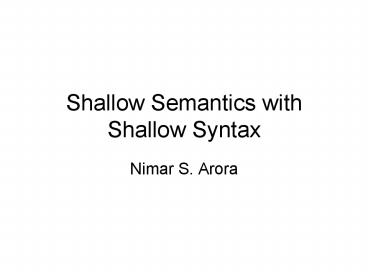Shallow Semantics with Shallow Syntax - PowerPoint PPT Presentation
1 / 15
Title:
Shallow Semantics with Shallow Syntax
Description:
Semantics is about constructing a logical form of human ... threw] [Agent, Body_part himself] [Manner with enthusiasm] [Goal into this exacting assignment] ... – PowerPoint PPT presentation
Number of Views:90
Avg rating:3.0/5.0
Title: Shallow Semantics with Shallow Syntax
1
Shallow Semantics with Shallow Syntax
- Nimar S. Arora
2
Shallow Semantics
- Semantics is about constructing a logical form of
human sentences to extract information, answer
questions, etc. Ex. - I ate popcorn ? eat (I, popcorn, t) tltnow
- Shallow semantics is about identifying the key
players in a sentence and how they interact - A prerequisite for creating the logical form, but
only a first step for bigger tasks
3
(No Transcript)
4
The Berkeley FrameNet Project
- Collin F. Baker, Charles J. Fillmore, John B.
Lowe, 1998 - Frames are an attempt to generalize semantic
patterns into a hierarchy - Consist of a target (the predicate) and frame
elements (arguments) - However, the roles are attached to the Frame and
not the target
5
Frame Example
- Duplication Frame
- The teacher was demonstrating on the blackboard ,
Creator the children Target copying Goal
onto slates . - Body_movement
- Agent Scott Target threw Agent, Body_part
himself Manner with enthusiasm Goal into this
exacting assignment .
6
The Task
- Pre-segmented constituents
- Given Frame and the target
- Label each constituent with a role
- Ignore null-instantiated elements
- 130K training sentences 13K test
- Parts-of-speech tags are available for training
7
Baseline
- Most Frequent Role 43
- Assigns all frame elements to the most frequent
role for the frame - i.e. argmax role P (role frame)
- Most Frequent Role Before or After 62
- Assigns all frame elements before target to one
role and all those elements after the target to
another
8
Phrase Type / First Word
- Recall ..Goal onto slates.. Goal into this
exacting assignment - The Goal role seems to begin with a preposition
- Similarly Agents, Creators, Inventors seem to
begin with articles - Such similarity exists across frames
9
Phrase Type / First Word
- Argmaxrole P(role frame)P(first word role)
- 76
- Duplication The teacher was demonstrating on the
blackboard Creator ? Original the children
Target copying Goal onto slates . - Children cant be copied!
- Somehow need to incorporate P(childrenOriginal)
vs. P(childrenCreator)
10
Head Word
- Last word doesnt help
- ..Goal to another file specially reserved for
the purpose.. ? Purpose - P(purposePurpose) higher than P(purposeGoal)
- Want to compare P(fileGoal) to P(filePurpose)
- First noun in the constituent is the head word or
None (single word constituents) - Different from Collins (1999) where prepositions
are the head of preposition phrases
11
Head Word
- Used part-of-speech (POS) tag labels (BNC and
PENN style) in training data to build taggers - Argmaxrole P(role frame)P(first word role)
P(head word role) - Problem Too little data
- Duplication And Original ? Goal the layout of
the walled garden long narrow beds , with
plants grouped according to their botanic family
, has been Target copied Place worldwide . - P(layoutOriginal) 0 but P(layoutGoal) gt 0
12
Hierarchical Counting
- FrameNet provides a hierarchy relating roles in
frames to super type roles in super type frames - For example, ManufacturingManufacturer ?
Intentionally_CreateCreator - An occurrence of ManufacturingManufacturer can
also be considered an occurrence of
Intentionally_CreateCreator and so on up the
super type hierarchy
13
Hierarchical Counting
- We can no longer condition on role because roles
dont have a hierarchy - Need to condition on both frame type and role
- 79
- Best is around 85
- using external resources for clustering nouns
- 80.4 otherwise (complicated interpolation)
- on FrameNet 1.2 which is half of FrameNet1.3
14
Future Approaches
- Deeper Syntactical information like parse trees
- Need more work on head word rules, example
children s book the head word is book rather
than children - Use adjectives and other phrases to better
discriminate head word sense. - Example the highlighted block is mistaken to
be a Place rather than Original - Use relations other than inheritance between
frames to enrich counts - Hierarchical smoothing, i.e. interpolate
P(headframe, role) with P(headparent frame,
parent role)
15
Conclusion
- The first word and the head word of a constituent
can give very good information about semantic
role - Head word can be computed by looking at
part-of-speech tags without parsing - The Frame rather than the target word is much
more critical for semantic role labeling - Hierarchical information about frames and roles
can help in smoothing the probabilities and
improve accuracy































